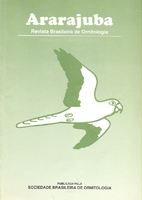
Comparative population densities of three species of doves (columbidae) in disturbed landscapes in northern Paraná State, Brazil
Abstract
Assessments of population density and contact number of individuals of the Eared Dove Zenaida auriculata were conducted in areas of the city of Londrina and were compared with those of two other species of the family Columbidae (Columbina talpacoti and C. picui). Data were collected from distance sampling in linear transects of 2,000 m. Analyses of density were calculated using the program DISTANCE. The results show that C. talpacoti and C. picui were recorded in all months in urban areas, and less frequently in rural and pasture areas. Zenaida auriculata was the most frequently recorded species in all areas, showing high rates of population density with seasonal variations; density peaks were observed during September and January in the urban area (coinciding with the arrival of warmer days in the region), while in rural areas, density peaks were also recorded during November/ December, March and April/May — periods in which planting of soybean and maize, and the soybean harvest, and wheat planting in the region, occurred, respectively. The density of Z. auriculata during these months showed a value that was 93 times greater in November/December and 75 times greater in April/May, compared to the density in the other months of the year. Although Z. auriculata was considered uncommon a few decades ago, we suggest that the removal of the original forest and the expansion of agriculture in the region have provided a large amount of seeds in the environment, which might favor the increased density of Z. auriculata in the region. The high rate of population density achieved by the Eared Dove suggests that the species has found a favorable environment in the region. This includes the ease of obtaining resources, suitable sites for nesting, reproductive success and possible adaptive factors, such as the opportunist movement in search of distant food sources.
Full Text:
PDF** The work of the Editor in Chief, Managing Office, Associate Editors, and the Editorial Council of Revista Brasileira de Ornitologia is strictly voluntary, and does not involve the use of any resources and infrastructure other than the personal ones**



